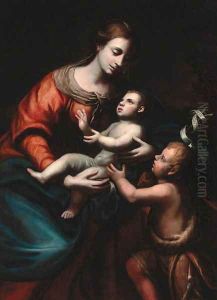Enea Talpino, Called Il Salmeggia Paintings
Enea Salmeggia, known as Il Salmeggia or Enea Talpino, was an Italian painter active during the late Renaissance period, primarily in the region of Lombardy. Born in 1556 in Bergamo, a city with a vibrant artistic scene during the 16th century, Salmeggia emerged as a prominent figure among the local painters of his time. His work is emblematic of the transition from Mannerist to early Baroque styles, reflecting the evolving tastes and artistic preferences of the late 16th and early 17th centuries.
Salmeggia's training and early influences remain somewhat obscure, but it is known that he was active in Bergamo and its surrounding areas, where he absorbed the rich artistic traditions of the Lombard school. His style suggests that he was aware of the works of contemporaneous artists such as Giovanni Battista Moroni and Lorenzo Lotto, who had also worked in Bergamo, as well as the influence of the Venetian school, particularly the colorism of Titian and Veronese.
Throughout his career, Il Salmeggia executed a number of religious commissions for local churches and institutions, demonstrating a profound ability to convey religious themes with emotional depth and technical precision. His altarpieces and frescoes are noted for their vibrant color palette and dynamic compositions, characteristics that aligned well with the emerging Baroque sensibility of the time.
Despite his success and contributions to the Lombard painting tradition, Salmeggia's work was somewhat overshadowed by the more dominant figures of the Italian Renaissance and Baroque periods. However, recent scholarship has begun to reassess his oeuvre, recognizing his role in the transition between major artistic movements and his influence on the generation of painters that followed. Enea Salmeggia died in 1626, leaving behind a legacy that, while not as widely recognized as that of his contemporaries, represents an important link in the chain of Italian art history.
